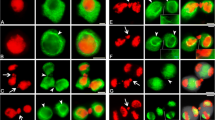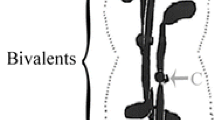Abstract
Micronuclear elongation is the first major event in a series of nuclear changes occurring during the sexual stage of the life cycle of Tetrahymena. Beginning at about one hour after cells of complementary mating types have conjugated, the micronucleus leaves its recess in the macronucleus and swells slightly. This is accompanied by a reorganization of its chromatin from a reticular to a solid body. In the next stage the micronucleus assumes an egg shape, a development concomitant with the appearance of microtubules. While the chromatin “spins out” from the dense body, and microtubules increase in number, the nucleus assumes a spindle shape. During the elongation, which increases the length of the nucleus some fifty fold, microtubules are prominent in clusters just internal to the nuclear membrane, and parallel to the longitudinal axis of the nucleus. When elongation is completed the nucleus is curved around the macronucleus. Internally, partially condensed strands of chromatin are located off-center, towards the macronuclear side, and the density of the microtubules is diminished. At all the stages, DNA is located throughout the nucleus; neither discrete chromosomes nor synaptonemal complexes are seen. Occasionally cytoplasmic membrane systems are seen fused to the nuclear envelope which retains the typical appearance of a double membrane with pores.
Similar content being viewed by others
References
Allewell, N. M., Oles, J., Wolfe, J.: A physicochemical analysis of conjugation in Tetrahymena. Exp. Cell Res. 97, 394–405 (1976)
Bajer, A. S., Molé-Bajer, J.: Spindle dynamics and chromosome movements. Int. Rev. Cytol. Suppl. 3, 1–271 (1972)
Doerder, F. P., DeBault, L. E.: Cylofluorimetric analysis of nuclear DNA during meiosis, fertilization and macronuclear development in the ciliate, Tetrahymena pyriformis, syngen 1. J. Cell Sci. 17, 471–493 (1975)
Dryl, S.: Antigenic transformation in Paramecium aurelia after homologous anti-serum treatment during autogamy and conjugation. J. Protozool. 6, 25A (1959)
Elliott, A. M.: Life cycle and distribution of Tetrahymena. In: Biology of Tetrahymena (A. M. Elliott, ed.), p. 259–286. Stroudsburg, Penna: Dowden, Hutchinson and Ross, Inc. 1973
Elliott, A. M., Hayes, R. E.: Mating types in Tetrahymena. Biol. Bull. 105, 269–284 (1953)
Elliott, A. M., Kennedy, J. R.: Morphology of Tetrahymena. In: Biology of Tetrahymena (A. M. Elliott, ed.), p. 57–87. Stroudsburg, Penna: Dowden, Hutchinson and Ross, Inc. 1973
Fulton, C. M.: Centrioles. In: Results and problems of cell differentiation. Vol. 2. Origin and continuity of cell organelles (J. Reinert and H. Ursprung, ed.), p. 170–221. Berlin-Heidelberg-New York: Springer 1971
Inoué, S.: Organization and function of the mitotic spindle. In: Primitive motile systems in cell biology (R. D. Allen and N. Kamiya, ed.), p. 549–594. New York: Academic Press, Inc. 1964
McIntosh, J. R., Hepler, P. K., VanWie, D. G.: Model for mitosis. Nature (Lond.) 224, 659–663 (1969)
McIntosh, J. R., Porter, K. R.: Microtubules in the spermatids of the domestic fowl. J. Cell Biol. 35, 153–173 (1967)
Mollenhauer, H. H.: Plastic embedding mixtures for use in electron microscopy. Stain Technol. 39, 111–114 (1964)
Moses, M. J.: Synaptinemal complex. Ann. Rev. Genet. 2, 363–412 (1968)
Nicklas, R. B.: Mitosis. In: Advances in cell biology (D. M. Prescott, L. Goldstein and E. H. McConkey, ed.), p. 225–297. New York: Appleton 1971
Ray, C., Jr.: Meiosis and nuclear behavior in Tetrahymena pyriformis. J. Protozool. 3, 88–96 (1956)
Rosenbaum, J. L., Child, F. M.: Flagellar regeneration in protozoan flagellates. J. Cell Biol. 34, 345–364 (1967)
Sumner, A. T.: A simple technique for demonstrating centromeric chromatin. Exp. Cell Res. 75, 304–406 (1972)
Tilney, L. G., Goddard, J.: Nucleating sites for the assembly of cytoplasmic microtubules in the ectodermal cells of blastulae of Arbacia punotulata. J. Cell Biol. 46, 564–575 (1970)
Westergaard, M., Wettstein, D. von: The synaptinemal complex. Ann. Rev. Genet. 6, 71–110 (1972)
Wolfe, J.: Basal body fine structure and chemistry. Advanc. Cell molec. Biol. 2, 151–192 (1972)
Wolfe, J.: Conjugation in Tetrahymena: The relationship between the division cycle and cell pairing. Develop. Biol. 35, 221–231
Author information
Authors and Affiliations
Rights and permissions
About this article
Cite this article
Wolfe, J., Hunter, B. & Adair, W.S. A cytological study of micronuclear elongation during conjugation in Tetrahymena . Chromosoma 55, 289–308 (1976). https://doi.org/10.1007/BF00292827
Received:
Accepted:
Issue Date:
DOI: https://doi.org/10.1007/BF00292827




